and so this is Christmas ...
Some icons we treasure
Christmas is a global celebration uniquely observed in many cultures.
Over the years, many legends, folktales and myths have surrounded this
significant religious event, bringing in various icons such as Santa
Claus, Christmas trees and Yule logs we’ve come to treasure so much
today. Just like the Nativity scene, or the crib that is displayed in
the churches and homes, these icons too have come to stay. So, let’s
check out the origin of some of them.
Santa Claus
Yes! He is your favourite. Who among you has still not written a
letter to Santa asking him to bring you all the toys you’ve been
dreaming of? Hurry up... and send him an e-mail, at least. Well, this
wonderful jolly old man with the long white beard and twinkling eyes is
believed to have become a part of Christmas, as a result of the Bishop
of Myra, St. Nicholase, who is known for his benevolence and love for
children.
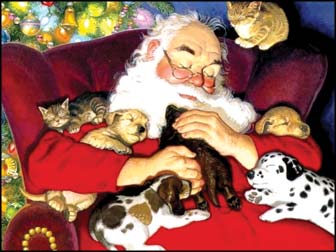 There are many legends about the origin of Santa Claus... who is said
to be living in Lapland. There are many legends about the origin of Santa Claus... who is said
to be living in Lapland.
Here are some of the names by which Santa Claus is known in other
countries.
Brazil - Papai Noel
Germany -
Der Weihnachtsmann
Netherlands -
Sinterklaas
United Kingdom -
Father Christmas
Norway - Julebukk
In our country we call him Naththal Seeya in Sinhala and Nattal
Thaththa in Tamil.
Candy canes
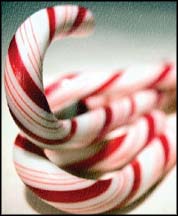 The J shaped candy canes in red and white originated in Cologne
Cathedra some 230 years ago. The candies which were originally not of
this shape were given to two little boys to keep them quiet during a
church service. As it was not accepted to give sweets in church it is
said the candies were bent like shepherd’s crooks to honour the
shepherds who first visited Baby Jesus.In 1847, an immigrant of German
descent in Ohio liked them so much that he used them as decor on his
Christmas tree. They were then mass produced in 1920 as decorations and
today there are many beautiful candy cane decorations. Some have
interpreted that the white symbolises the piety of Jesus and the red,
the wounds He suffered. The shape, they claim stands for the letter J,
which is the first letter in Jesus, and not for the shepherd’s crook. The J shaped candy canes in red and white originated in Cologne
Cathedra some 230 years ago. The candies which were originally not of
this shape were given to two little boys to keep them quiet during a
church service. As it was not accepted to give sweets in church it is
said the candies were bent like shepherd’s crooks to honour the
shepherds who first visited Baby Jesus.In 1847, an immigrant of German
descent in Ohio liked them so much that he used them as decor on his
Christmas tree. They were then mass produced in 1920 as decorations and
today there are many beautiful candy cane decorations. Some have
interpreted that the white symbolises the piety of Jesus and the red,
the wounds He suffered. The shape, they claim stands for the letter J,
which is the first letter in Jesus, and not for the shepherd’s crook.
Christmas tree
 The first Christmas tree was set up by Martin Luther way back in 1935
for his children. Prince Albert is believed to have introduced this
custom from Germany to Windsor Castle in 1841. The first Christmas tree was set up by Martin Luther way back in 1935
for his children. Prince Albert is believed to have introduced this
custom from Germany to Windsor Castle in 1841.
Frosty the Snowman
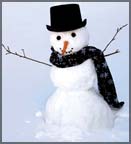 A popular figure during the festive season; children in countries
where the winter season is experienced enjoy making snowmen during
winter. A popular figure during the festive season; children in countries
where the winter season is experienced enjoy making snowmen during
winter.
The roly-poly figures comprising two snowballs or sometimes three,
are now very much a part of Christmas.
The popular character, Frosty the Snowman was a Tin Pan novelty
created as a follow-up to Rudolph the Red-Nosed Reindeer by Jack Nelson
and Steve Rolling in 1950. Later the song was sold to Gene Autry who
recorded it. There are many children’s books and cartoons in Frosty’s
honour.
Rudolph the Red-Nosed Reindeer
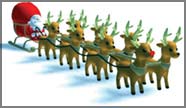 He is believed to be Santa’s lead reindeer, who guides the sleigh.
The other eight reindeer who drew Santa’s sleigh on his trips around the
world to distribute the toys are: Dasher, Dancer, Prancer, Vixen, Comet,
Cupid Donner and Blitzen. He is believed to be Santa’s lead reindeer, who guides the sleigh.
The other eight reindeer who drew Santa’s sleigh on his trips around the
world to distribute the toys are: Dasher, Dancer, Prancer, Vixen, Comet,
Cupid Donner and Blitzen.
Seasonal fare Spiritual message ...
An event of great religious significance in the Catholic/Christian
calender will dawn in a few days time, uniting the faithful followers
the world over in a spirit of peace, love and harmony.
Christmas which is celebrated on December 25 every year marks the
birth of the Prince of Peace - Jesus Christ - more than 2,000 years ago
in the little town of Bethlehem. By now most of you must be familiar
with the Nativity and the incidents that led up to the birth of Jesus,
the spiritual leader of millions today.
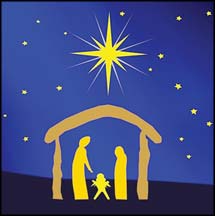 Many may wonder as to why Jesus was born in a stable with only a
manger as a crib when He could have been born in a palace, surrounded
with all the luxuries and comforts. Well, there is a reason for Jesus
being born in such humble surroundings with poor, humble shepherds as
His first visitors. Of course there were the three wise men or the kings
(also called the Magi), who travelled from far away places, following a
bright star in the sky to pay homage to the Baby Jesus. But, it was to
the shepherds that the angels of God first proclaimed the wonderful
message that “.... unto you is born today in the Royal city of David, a
Saviour who is Christ the Lord.” Many may wonder as to why Jesus was born in a stable with only a
manger as a crib when He could have been born in a palace, surrounded
with all the luxuries and comforts. Well, there is a reason for Jesus
being born in such humble surroundings with poor, humble shepherds as
His first visitors. Of course there were the three wise men or the kings
(also called the Magi), who travelled from far away places, following a
bright star in the sky to pay homage to the Baby Jesus. But, it was to
the shepherds that the angels of God first proclaimed the wonderful
message that “.... unto you is born today in the Royal city of David, a
Saviour who is Christ the Lord.”
The birth of Jesus is not just a date in the Christian calendar or a
religious event that faded into oblivion (was forgotten) with time; it
was the beginning of a whole new era for those who believed in the
existence of God. With the significant birth of Jesus was born a
stronger bonding with God and the human race; for Jesus is believed to
be the Son of God who came into this world to save all mankind. Through
His humble birth, the message of humility and hope, love and peace was
spread throughout the world...
Even though Christmas, which marks the birth of Jesus is not
celebrated on the exact day He was actually born (with the original date
not being clearly recorded), December 25 which was declared as the day
to celebrate this event, is widely accepted today. And so, we all look
forward to this great day as the year draws to a close... However, as
with most significant events, religious or otherwise, Christmas too has
become a highly commercialised event today with the true spirit of the
season and the hallowed spiritual message of peace, love and harmony
taking second place to a materialistic celebration of the great event;
tinsel trimmings and merry making are what many focus attention on
today.The Prince of Peace was born to usher in peace to this world,
something we humans in many parts of the world are searching and longing
for.
Peace is indeed the need of the hour and Christmas is an ideal time
to reflect on the true meaning of peace which can only exist in this
world if we learn to accept each other as members of one big family -
the human race, irrespective of our religious beliefs, ethnic and
cultural differences and social standings. All spiritual leaders have,
over the years, strived to guide humanity in the right path. The
spiritual light they have tried to kindle in us through their great
teachings is like the illumination we see through a many faceted
lantern. Though seen from many views, all spiritual leaders convey the
same message; to live in peace and love each other.
Christmas is the most wonderful time of the year... especially for
Catholic/Christian children, with mouth-watering sweetmeats galore,
plenty of new clothes to wear, places to visit and gifts to unwrap. And
hey, what about that jolly old man who comes all the way from the North
Pole, loaded with toys?
Yes, Christmas is a time that fills the hearts of children with so
much joy and excitement. Even though you may be too young to reflect too
deeply on the true meaning of this spiritual event, and will be totally
caught up only in the fun and frolic that comes with the season, you are
certainly not incapable of sparing a thought for all those who are in
need of a helping hand, not just due to poverty, but also due to various
other reasons such as the war, natural disasters, illnesses, violence
and crime.You can make Christmas more meaningful for them because it is
the season of giving!
Miru
Facts, myths and legends
* Oliver Cromwell who once ruled England was of the view that
Christmas celebrations should be a solemn one. He banned Christmas
carols in 1649 and 1660. The only celebration was a prayer service and a
sermon.
* In 1643, the British Parliament abolished the celebration of
Christmas.
* The common abbreviation for Christmas - X’mas is derived from the
Greek alphabet. The letter X stands for Chi in the Greek alphabet, and
is the first letter for Christ’s name in the Greek alphabet.
* Crackers or bon bons were first made in London by a sweet maker
named Tom Smith.
* The first postage stamp to commemorate Christmas was issued in
Austria in 1937.
* Alabama became the first State in the USA to declare Christmas as a
legal holiday in 1836.
* The song “Twelve Days of Christmas’ was originally a children’s
rhyme which was published in a book called Mirth without Mischief, in
London in 1780. It was initially used in a memory and forfeit game, but
a century later it was adapted into a cumulative song; meaning each
verse is built on top of the previous verses.
* In 1914 during the World War, suddenly at midnight on Christmas
eve, firing from the German trenches had ceased. A German brass band had
then started playing Christmas carols. The Allied soldiers had been
surprised by this act. Early Christmas morning, the German soldiers had
come out of their trenches and approached the Allied lines calling out
‘Merry Christmas’. The Allied Forces had been suspicious, thinking it is
a trick used by the Germans.But on realising it wasn’t so, they too had
climbed out of the trenches and shook hands with the enemy soldiers.
They had then exchanged presents of cigarettes and plum puddings and
even played a game of soccer. The truce is said to have lasted a few
days before the fighting was resumed again.
* President Franklin Pierce enjoyed viewing the first decorated
Christmas tree at the White House .
* The traditional colours of Christmas are green and red. It is
believed that while green represents the continuity of life through the
winter and the Christian belief of eternal life through Jesus Christ,
the colour red symbolises the blood Jesus shed when He was crucified.
* Carols are religious songs, associated with Christmas. One of the
earliest English carols is the ‘Boor’s Head Carol’ printed in 1521. The
word carol meant a song or dance of praise.
* The legend of flying reindeer is believed to have originated as
early as the 19th century as a result of the poem ‘Twas the night before
Christmas’ by Clement Clarke Moore. |
